A quick-running animal classified as an antelope, the impala impresses with its streamlined agility. In their savannas, impalas feed on greenery and gather in large numbers, especially after it rains, and vegetation grows.
Do you wish to learn more about the amazing animal that is the impala? This guide will provide fascinating facts from start to finish, including traits, how the impala escapes predators, dietary information, reproduction, and desired habitat.
What Is an Impala?
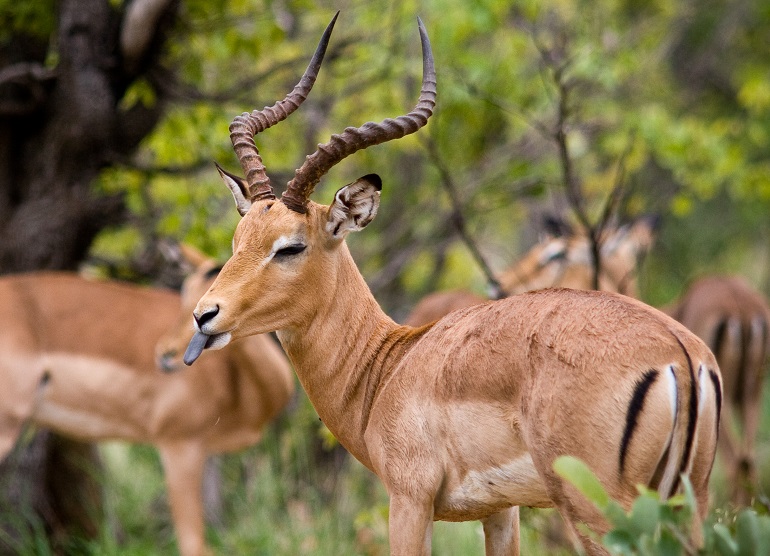
Referred to by some as the rooibok, the impala is a mid-sized animal from southern and eastern Africa.
As a type of antelope, the impala has existed since at least 1812, when Hinrich Lichenstein, a zoologist, shared findings on the creature. Some variety of the impala’s name has been around for even longer.
Only male impalas grow horns. The rams, as they’re called, can develop horns between 18 and 36 inches in length. Females or ewes stand out for their lack of horns.
Etymology of Impala
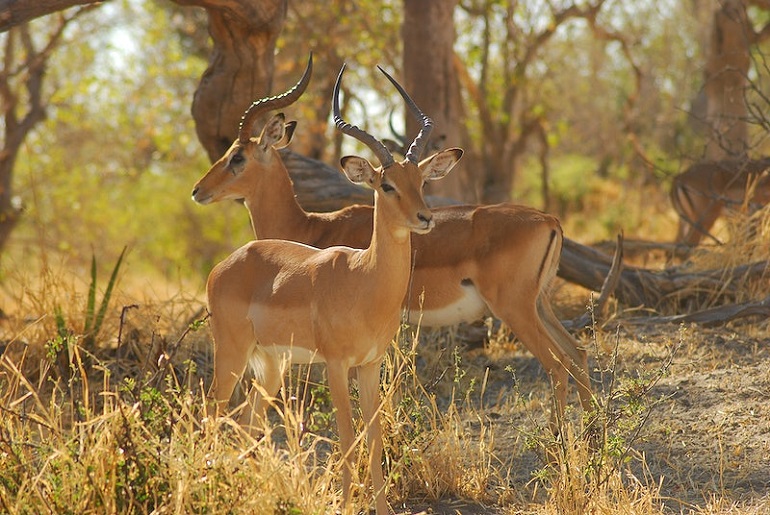
So where does the name impala come from, anyway?
Well, despite the German zoologist Lichenstein introducing impalas to the world in 1812, the origins of this animal’s English name go back to 1802.
At the time, the world called impalas simply palla. An alternate spelling had an H at the end.
The name originates from the Bantu language Tswana and the word phala, which means “red antelope.”
When the name impala was applied by 1875, this too came from a Bantu language, this time Zulu.
So what about rooibok, another nickname for the impala? That’s the animal’s name in Afrikaans and means “red buck,” also fitting!
The impala belongs to the Aepyceros genus, with that name an Ancient Greek term that means “high-horned.”
Taxonomic Hierarchy and Evolutionary Status
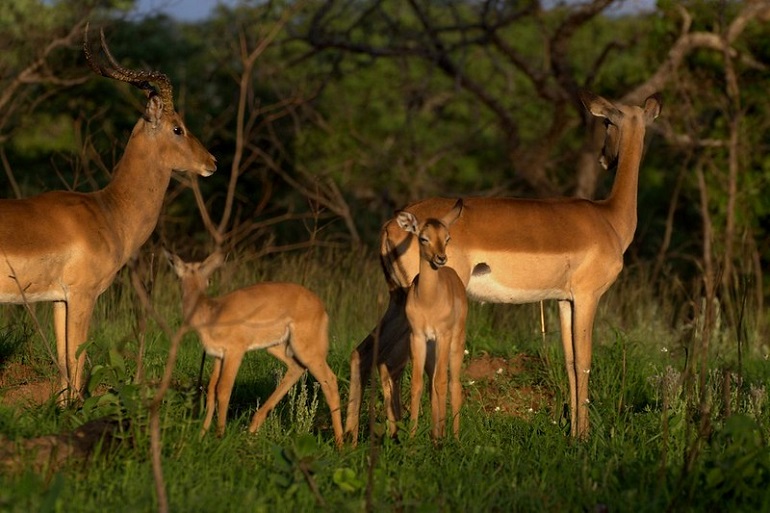
Speaking of its genus, let’s delve deeper into the impala’s taxonomic hierarchy.
Like all animals, it’s in the Animalia kingdom. The impala belongs to the Chordata phylum, Mammalia class, Artiodactyla order, and Bovidae family.
Bovidae members are grazing hoofed animals such as caprines, antelopes, buffalo, bison, and cattle. There exist 143 boviade or bovid species.
The Impala is part of the Aepycerotini tribe and the Aepyceros genus. That genus includes only the impala but technically encompasses African antelopes.
The Aepyceros shungurae and Aepyceros datoadeni came before and have both since gone extinct.
The Aepyceros premelampus, once belonging to the Aepyceros genus, has now moved to the Afrotragus genus.
Despite the many impala subspecies identified over the years (up to six), today, we recognize only two species today. There’s the A. m. melampus first discovered in 1812 by Lichenstein, which many call the common impala.
Still living to this day, the common impala favors regions such as southeastern Angola, South Africa, and central Kenya.
The second species is A. m. petersi, discovered in 1879 by Jose Vicente Barbosa du Bocage. Known as the black-faced impala, this creature today lives in southwestern Angola and northwestern Namibia.
Evolutionary Basis
Evolution gives us an exciting glimpse into the history of animals over centuries to understand how we’ve arrived at the creatures that inhabit the planet today.
A cladogram connects these animal relationships.
Sheep or Ovis aries share a relationship with sable antelopes or Hippotragus niger and bontebok or Damaliscus pygargus.
Also related to sheep and interrelated amongst themselves are the bay duiker or Cephalophus dorsalis and the klipspringer or Oreotragus oreotragus.
Those two animals are related to the impala and suni or Neotragus moschatus, which does tie back to sheep.
Related to klipspringers are mountain reedbucks or Redunca fulvorufula and Grant’s gazelles or Nanger granti.
Traits of Impala
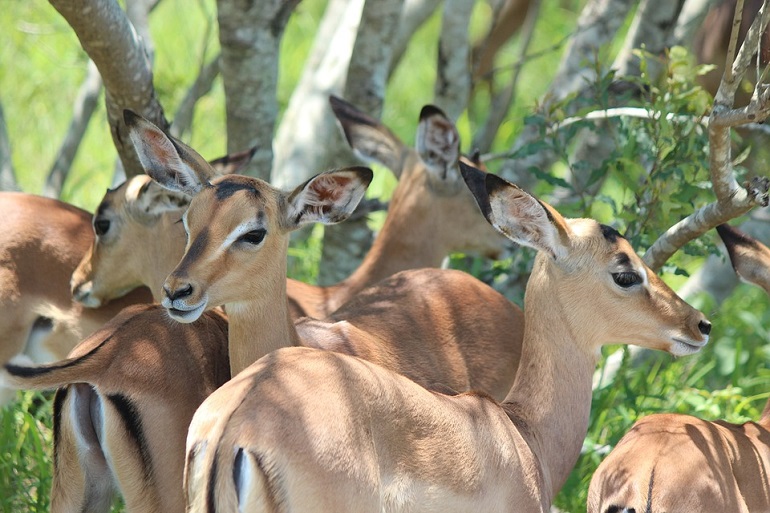
Impalas stand between 28 and 36 inches tall and weigh no more than 168 pounds. They have lean, streamlined profiles with slender necks, long legs with hooves, and horns atop their heads.
The horns have a shape akin to the musical instrument known as the lyre. The horns usually don’t grow straight but with a curve, thicker at the base before tapering off at the ends.
Impalas have fur across their bodies. The fur has a glossy texture, usually reddish brown, with white underbellies. The buttocks, upper throat, and chin also display white hair, as does the fur that grows over the impala’s eyes.
A black stripe runs from the center of the impala’s lower back, all the way to its small, flat tail. The stripe continues vertically on the back of each leg.
Impala Animal Facts
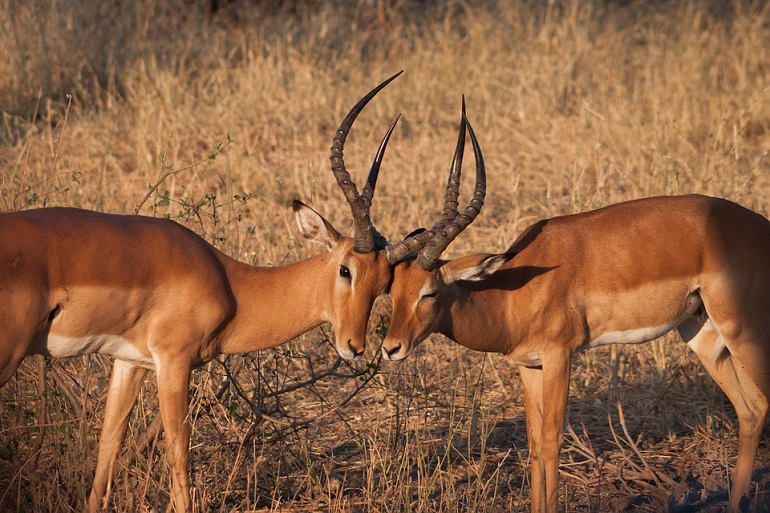
Want to know even more about the impala? Check out these great animal facts!
- Impalas can jump three meters or 10 feet high.
- They’re very graceful creatures capable of jumping 10 meters or 33 feet in one leap
- When an impala is born, rain usually follows soon thereafter. This is interesting, considering females birth calves all year long!
- Although the way an impala jumps seems random or even confusing, it’s intentional to ward off predators.
- Territorial male impalas sometimes switch to bachelor herds and then back to the harem, depending on the time of the year.
- Oxpeckers like to live in a symbiotic relationship with impalas to ingest the ticks that could make an impala very sick or even kill it. Oxpeckers eat the ticks from the parts of the impala it otherwise can’t access on its own body.
Impala Behavior
What kind of behavioral traits do impalas display? Let’s review them here.
Activity Periods
Impalas roam during the daytime, spending their time seeking out sources of food. If necessary, an impala will remain out after sunset to feed. The animal also rests in the evenings.
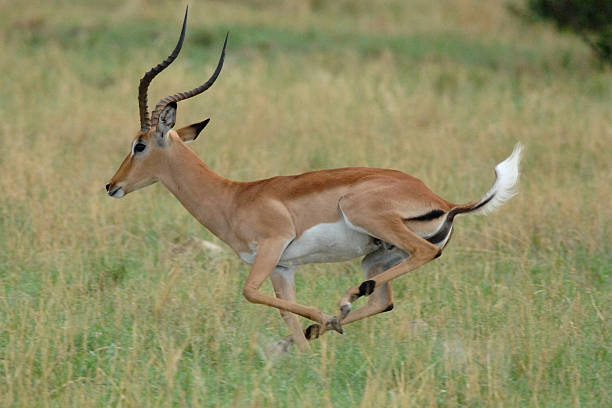
During hot days, which occur quite frequently in eastern and southern Africa, the impala will reduce its activity levels to conserve energy and avoid overheating.
Grazing
The life of an impala consists of two main tasks, grazing and browsing.
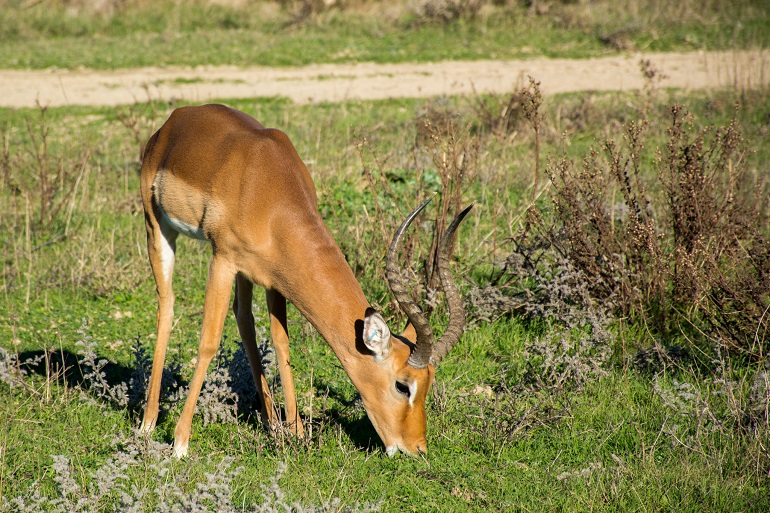
Grazing is another word for foraging. The herbivorous impala will spend its time seeking sources of food.
When it finds its food, the impala begins browsing, another word for herbivorous feeding on fruits, shoots, leaves, shrubs, and other vegetation.
Territoriality
Impalas can display territorial behavior, but whether they do varies based on geography, climate, and season.
For example, each year around May, when the rainy season ends, impalas enter a rutting period.
These three weeks entail the male impalas striving to determine who among them is the most dominant. That male gets to approach an available female and reproduce.
Non-territorial impalas live in herds. There’s one female herd and two male herds, the bachelor herd, where males will engage in rutting, and the territorial male herd.
Group Behavior
Impalas tend to group together, especially among territorial males. These males create impala harems with several females and any resultant offspring. Territorial impalas will use feces and urine marking to keep bachelor males out of the harem.
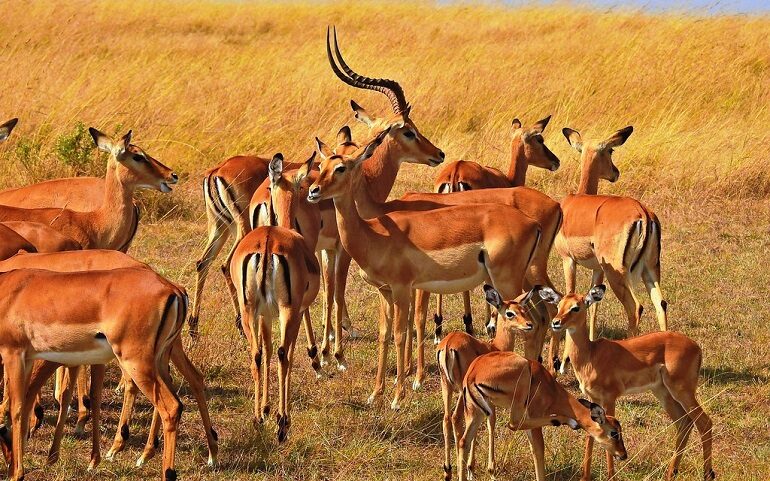
A bachelor herd is much smaller by comparison, consisting of maybe 30 impalas at most, but usually fewer. The males don’t share the same level of interactivity as seen in a harem unless they’re very old or young.
The general distance between impala males in the bachelor herd is nine feet. When any interaction occurs, it’s usually sparring between the two impalas.
Female herds outnumber all the other impala groups, or at least they can. These herds may have as few as six females but sometimes up to 100. The animals need somewhere between 200 and 400 acres of space.
Female impalas may move to the harem with their children. Those children will eventually go to the bachelor herd.
The female herd members interact more with one another than in bachelor herds, as the females engage in allogrooming. This form of grooming involves an animal using its mouth or body part to clean the other and remove parasites.
Impalas are quite prone to parasites, including ixodid ticks, some of which can cause tick paralysis that kills impalas.
Interestingly, males in the bachelor herd will sometimes engage in allogrooming, but not with related males. Female impalas groom other impalas they belong to.
Escaping Predators
Many animal species prey on the impala, from pythons to crocodiles, hyenas, lions, wild dogs, leopards, and cheetahs.
How does the impala escape?
Well, by jumping, for one. When surprised by a predator, an impala will leap high, then move its body from its left to its right. This keeps the herd in formation, so they’re not at risk of predators.
The way the impala jumps and then lands can change to confuse or distract predators.
Impalas can also run at high speeds to get away from predators, and they’ll jump nimbly over obstacles in their way.
If the impala has vegetation nearby that it can use to its advantage, it will do so, hiding there until a threat passes.
However, impalas will not venture near tall grass, as it’s too difficult to tell which predators might linger there.
You might wonder, do impalas use their horns to ward off predators? Not really. They will engage their horns in combat, but usually with other male impalas when rutting.
Diet and Nutrition of Impala
You’ll recall that impalas are herbivores, so they feed only on vegetation, not animal products or byproducts.
Impalas eat the vegetation available to them throughout the year. That often includes acacia pods, forbs, dicots, and monocots.
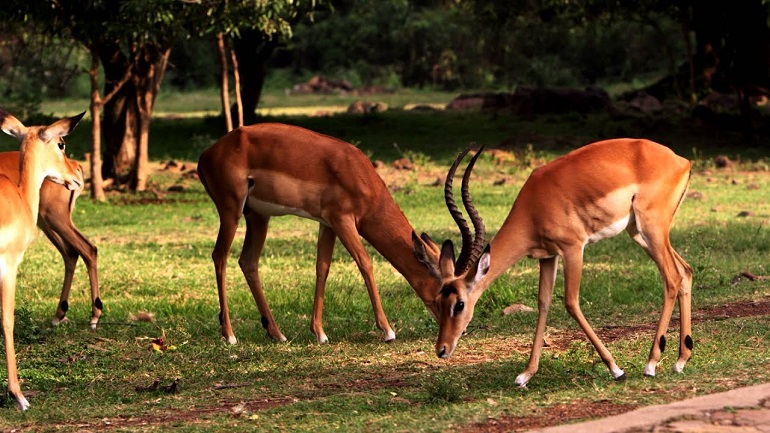
Primarily, they eat dicots and monocots, with only a small portion of their diet including fruits. Territorial males may eat fewer dicots than females and bachelors.
If grasses are more readily available, then that’s what the impala will feed on. During dry periods, impalas will avoid possibly dehydrating themselves by skipping taller and tougher grass species. They primarily eat Digitaria macroblephara grasses, which are much softer and packed with more nutrients.
If necessary, impalas will even suck the waters from succulents, which store H2O in their fleshy leaves.
Ideally, an impala will live around a water source, yet even the availability of water can change throughout the year.
Mating and Reproduction
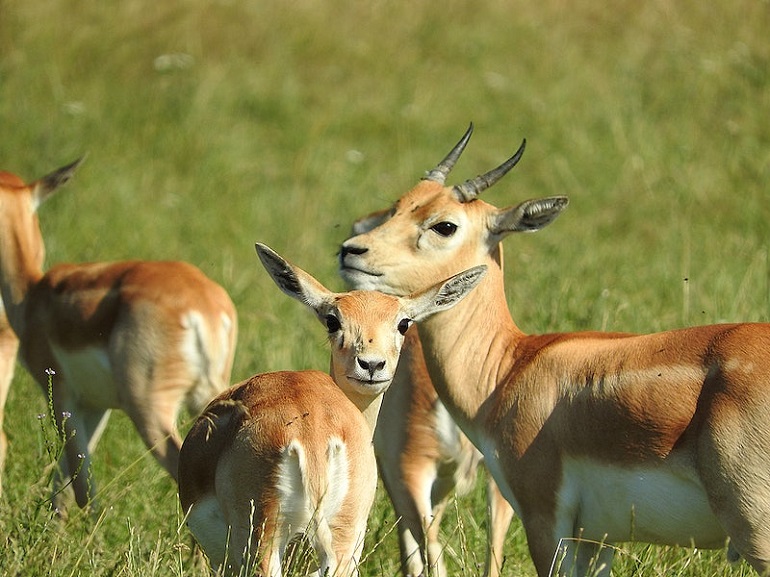
It takes a male impala only a year to reach sexual maturity, but the animal usually waits until around four years old to begin reproducing. Females enter estrus once they’re about a year and a half old.
Estrus is the female reproductive cycle when a female can become pregnant. She’ll repeat estrus about every 12 to 29 days; the period lasts at least 24 hours but sometimes twice that.
When males begin rutting around May, they’ll seek females in estrus from the female herd. A male impala will sniff the urine of a female, as the scent confirms that she’s in heat.
Then the male will stay back about 10 feet but begin nodding and flicking his tongue. After the male and female mate, the male has no interest in repeating the act with the same female, but the female can reproduce with other male impalas.
A pregnant female impala gestates for six or seven months. When she senses she’s in labor, the pregnant impala will go off on her own and birth a calf.
The female covers the calf for several weeks. When she deems it ready, the female takes her calf either to her own herd or to a harem.
Within four to six months, the mother considers the male calf mature enough to venture off independently. The calf will usually join a bachelor herd.
If the female gives birth to another female calf, that calf will stay with the female herd.
Impala’s Lifespan
The impala lifespan typically lasts 13 years, although some can live for up to 15 years. Diseases, illnesses, predation, and lack of food sources can kill off impalas.
Habitat of Impala
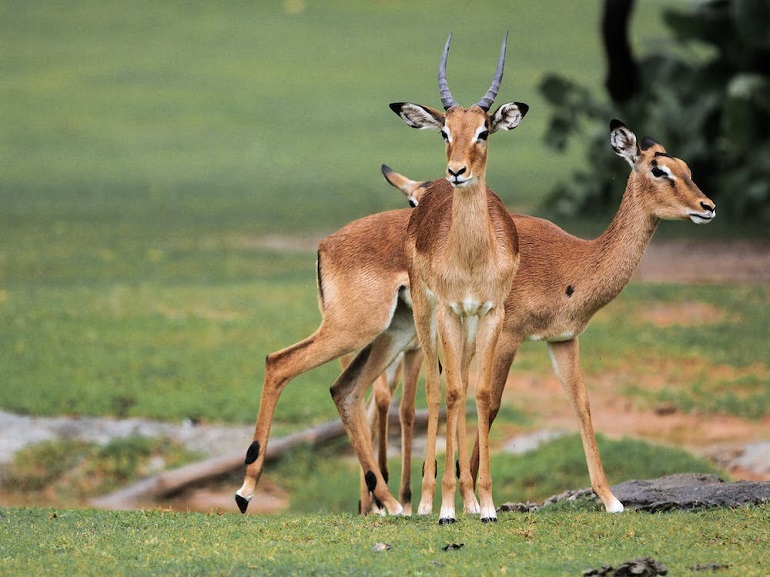
The impala calls southern and eastern Africa home. There, the animal vacillates between savannahs and woodlands, seeking out whichever environment has more water. Typically, that’s savannahs in dry weather and woodlands during the rainy season.
Population Threats and Conservation
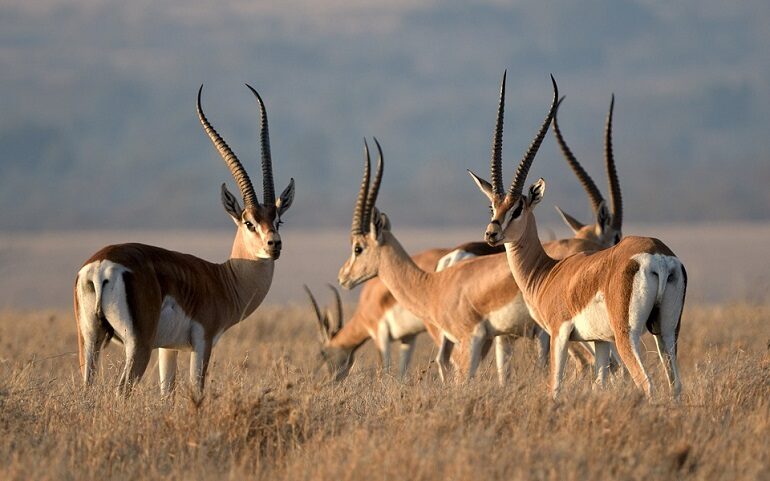
Although the natural food chain plays out and impalas become the meals of other animals, they’re not currently facing any major threats of excintion.
The only exception is the black-faced impala, which the Conservation of Nature and Natural Resources deems vulnerable. That means its numbers have dwindled, but the black-faced impala has not reached endangered status yet.
Part of what allows impalas to remain in such high numbers overall is their proximity to protected areas in Africa. To preserve black-faced impalas, Africans have moved some to private farms.
Conclusion
Impalas are eastern and southern African antelopes gifted at jumping, running, and maintaining great speeds. They’re herbivorous creatures with spiral, curved horns that live in small groups or communities.
You may have only seen impalas at the zoo, or perhaps never before in real life. We hope this post enlightened you on the unique behaviors of the impala!


